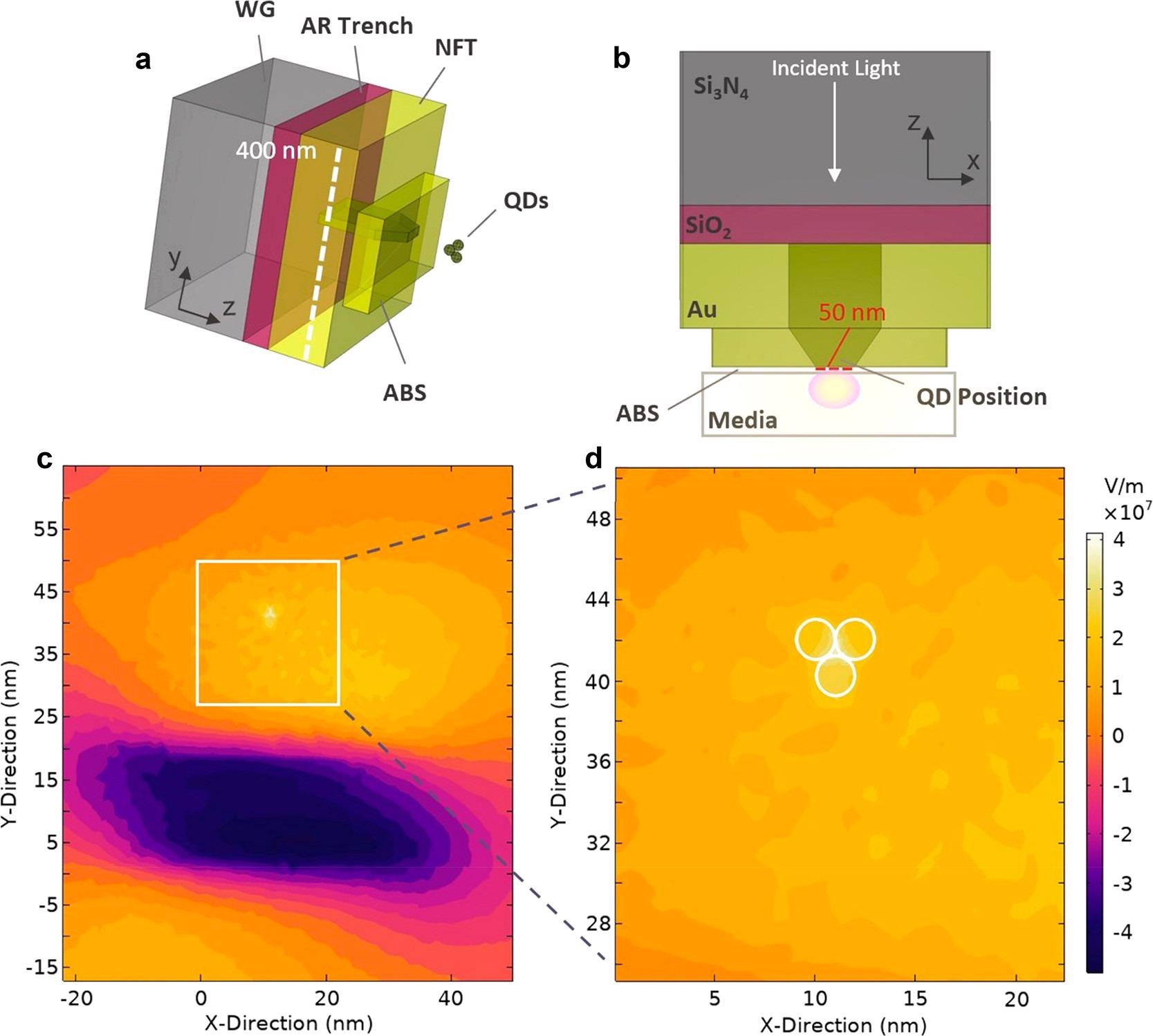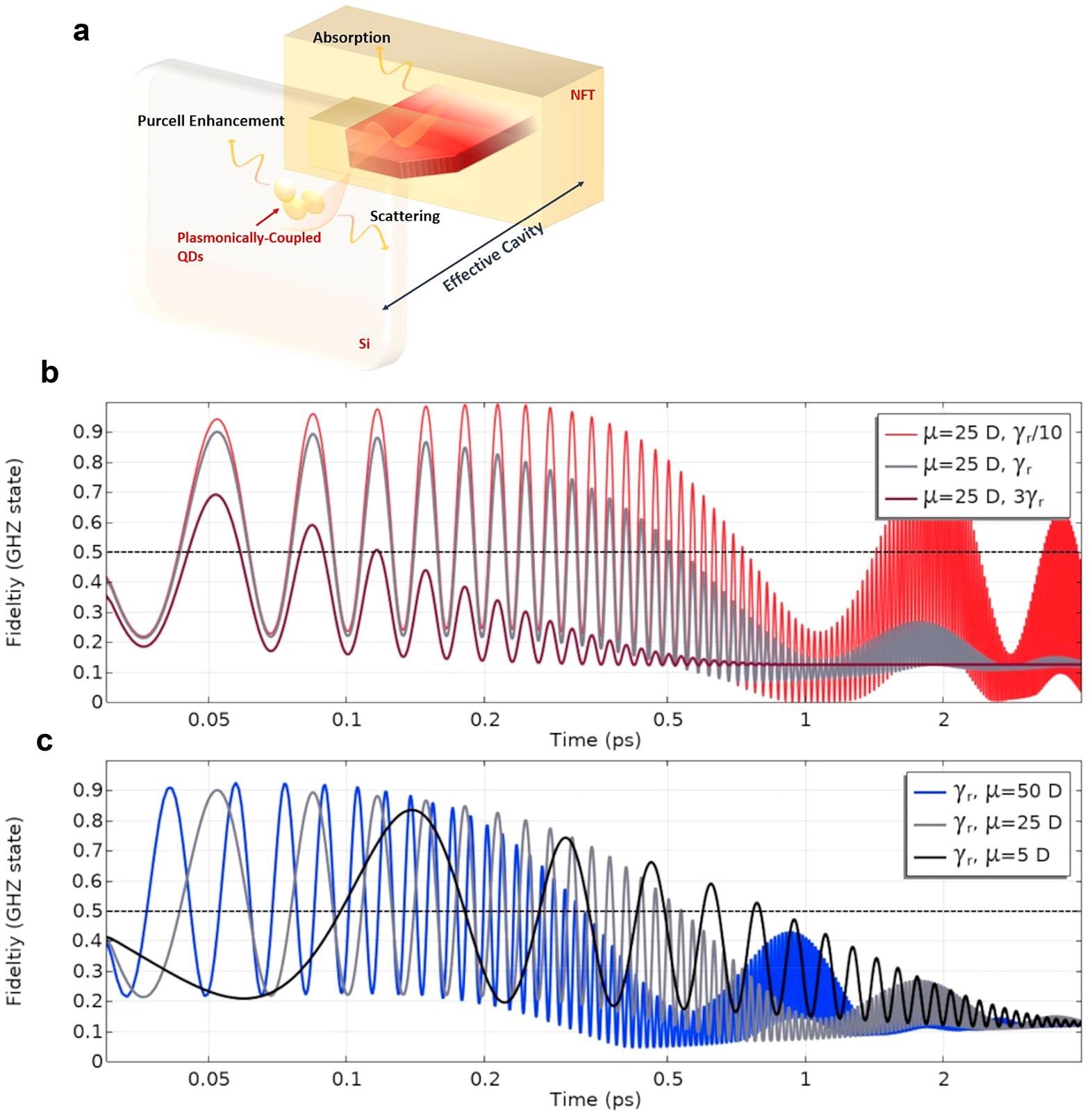A team of researchers recently published a paper in the journal Nano Letters that demonstrated the effectiveness of a quantum dot-near-field transducer (QD-NFT) system to achieve ultrafast multipartite entanglement for quantum nanoplasmonic networks at room temperature.

Study: Near-Field Generation and Control of Ultrafast, Multipartite Entanglement for Quantum Nanoplasmonic Networks. Image Credit: Jurik Peter/Shutterstock.com
Limitations of Existing Quantum Computing Devices
In quantum internet platforms, reliable entangled particle sources are required that are compatible with the measurement techniques enabling quantum error correction in a time-dependent manner. Additionally, these entangled particles should be operable with manageable decoherence versus generation time at room temperature. However, decoherence effects scan adversely impact the current superconducting quantum interference devices (SQUIDs)-based quantum networks.
Next-generation computational technologies such as noisy intermediate-scale quantum (NISQ) computers and their inclusive networks are gaining considerable attention owing to the increasing significance of quantum computation. NISQ computers consist of 50-100 quantum bits (qubits) and can provide solutions to complex problems when integrated with classical computing at a significantly faster rate compared to existing supercomputers. However, the decoherence and the eventual dephasing are also expected to impact several NISQ computer designs.
Photonic quantum computers have recently gained attention as they can be efficiently operated at room temperature without significant decoherence effects. These computers were already used to successfully perform small-scale classical computations.
New Strategy to Overcome the Limitations and Achieve Ultrafast Multipartite Entanglement
In this study, researchers established a nanoplasmonically based scalable archetype that uses QDs as quantum emitters excited by a subdiffraction light from an NFT. QDs were selected owing to their low coherence at room temperature. NFTs are an emerging technology that enables rasterization across the qubit arrays and generates sufficient power to strongly drive nanoscale energy transitions.
A minimal, to-scale model of the NFT composed of a tapered silicon dioxide (SiO2) layer and gold (Au) was utilized to subdiffract light at the nanoscale to excite three QDs. A single-mode silicon nitride waveguide was used to excite an antisymmetric surface plasmon mode at 830 nanometers wavelength in the NFT for nanofocusing. The subdiffracted light was then coupled with the two nanometers silicon (Si)-based QDs that were centered at 1.5 nanometers below the QD media surface boundary. A SiO2-based antireflective trench was employed to improve optical efficiency.
Researchers investigated this three-quantum bit model and used a system of two-level identical QDs that were analogous to several spin-½ systems. They used density matrix formalism to determine the fidelity of entanglement for evaluating the QD dynamics that were quantitively coupled to the electric field in time and space using Maxwell’s equations.

(a,b) A to-scale, minimal model of the NFT used to subdiffract light on the nanoscale along with three quantum dots. The single mode, silicon nitride waveguide (WG) excites an antisymmetric surface plasmon mode at wavelength of 830 nm in the NFT composed of Au and tapered SiO2 layer for nanofocusing. The light then couples to Si-based QDs of 2 nm in diameter and centered at 1.5 nm below the surface boundary of the QD media (see Supporting Information for alternative positioning). An antireflective (AR) trench composed of the same material as the tapered insulator (SiO2) is used to improve optical efficiency. (c) Steady-state field, Re(Ez), that couples to the QD dipole moments aligned in the z-direction. It is slightly skewed (to the right) rather than symmetric due light interacting with the QDs. (d) Contouring and overall strength of light scattered at the QDs’ position is highlighted. The 0-point on the figures represents the same position as the lower corner of the tapered insulator roughly centered in the NFT (see Supporting Information for parameter list).© Hess, O., Kongsuwan, N., Bello, F.D. et al. (2022)
Simulation and Theoretical Methods Used in the Study
The steady-state, full-field solution of Maxwell’s equation for the metal-insulator-metal (MIM)-NFT resonator and photonic waveguide was solved to derive incident electric field on the quantum dot (QD) media using finite-element time-domain (FETD) simulations. At 830 nanometers wavelength, the two micrometers long photonic waveguide was considered to be under the maximum input power of 17 milliwatts, with almost 24% of the peak input power reaching the QD layer. The input power maintained the Au temperature at 400 Kelvin to prevent any potential damage to NFT due to protruding of the metal.
The time-dependent density matrix of the qubit system was solved for spin-½ QDs. The effect of QDs on the surrounding environment was determined using Maxwell’s equations by calculating the polarization induced by the dipole moment of QDs, where every variable is a function of three-dimensional space and time. The density matrix was formed by obtaining the tensor product for three, two-level QDs defined by a wave function using the standard basis rate of individual QD.

(a) Schematic of the effective open-cavity system consisting of the NFT which propagates light via an SPP mode that subsequently couples to the QDs placed in separate media. We emphasize several contributions to the decay and dephasing rates such as the Purcell enhancement (radiative) along with scattering or absorption loss. Altogether, these are anticipated to yield ultrafast (picosecond-scale) lifetimes which we use in our investigation. (32) Various fabrication techniques, along with a number of possible NFTs, can be used to produce nanofocused light. All of which can lead to changes to the decay (γr) and dephasing rates (4γr) in the NFT+QD system. (b) We assume some variations to the radiative decay rate used (γr = 1.2 × 1011 s–1) with good fidelity noticed for decay rates as high as 3γr (dephasing = 12γr). (c) Depending on the dipole moment, the time period that one sees oscillations with fidelities above 0.5, that is, multipartite entanglement, can be extended using a lower strength, for example, that of 5 D. Fidelities could be increased for stronger moments, such as 25 or 50 D, where more rapid oscillations are shown to occur and anticipated given the faster Rabi oscillation rates for larger dipole moments. For the scenario presented, GHZ entanglement disappears when the decay rate is increased 5× (5γr) with dephasing rates also increased to 20γr (2.4 × 1012 s–1). © Hess, O., Kongsuwan, N., Bello, F.D. et al. (2022)
Significance of the Study
The study verified the substantial potential of the NFT-promoted near-field nanoplasmonics to control and generate multipartite entanglement, which included appropriate time-dependent dephasing effects at room temperature. Effective control over quantum entanglement was observed when the open-cavity QD-NFT system was excited with near-field, nanoscale-focused light from the NFT.
Additionally, the archetypal QD-NFT system expanded the possibilities of performing multipartite quantum logic gates by maintaining the moveability of the NFT structure and control over QDs. In addition to driving the QD systems, NFTs can also provide rastering capability and effective multipartite entanglement with optimal fidelity that generates adequate entanglement before the dephasing rates decohere the two-level QD system. Multipartite entanglement occurred in the system owing to the manipulation of the Greenberger−Horne−Zeilinger (GHZ3) state excitation.
The efficient manipulation of quantum entanglement and superposition, including the significant dephasing on an ultrafast and nanoscale, displayed the effectiveness of the strategy to perform fault-tolerant and more efficient operations in multipartite, on-chip quantum devices. Moreover, the study also displayed that ultrafast control over bipartite/tripartite entanglement can be achieved by employing advanced manufacturing techniques that can control initial media, embedding media, incident power, and dipole moments.
Taken together, the findings of this study demonstrated that the strategy of using the QD-NFT system to achieve multipartite entanglement can potentially increase the accessibility and scalability of quantum information devices.
Reference
Hess, O., Kongsuwan, N., Bello, F.D. et al. (2022) Near-Field Generation and Control of Ultrafast, Multipartite Entanglement for Quantum Nanoplasmonic Networks. Nano Letters. https://pubs.acs.org/doi/10.1021/acs.nanolett.1c04920
Disclaimer: The views expressed here are those of the author expressed in their private capacity and do not necessarily represent the views of AZoM.com Limited T/A AZoNetwork the owner and operator of this website. This disclaimer forms part of the Terms and conditions of use of this website.